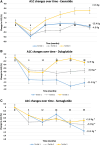Is Weight Loss the Main Driver for A1C Improvement by Glucagon-Like Peptide 1 (GLP-1) Receptor Agonists? A 2.5-Year Analysis in Real-World Clinical Practice
- PMID: 39853913
- PMCID: PMC11757277
- DOI: 10.1111/1753-0407.70054
Is Weight Loss the Main Driver for A1C Improvement by Glucagon-Like Peptide 1 (GLP-1) Receptor Agonists? A 2.5-Year Analysis in Real-World Clinical Practice
Abstract
Background: Glucagon-like peptide-1 receptor agonists (GLP-1 RAs) are established treatment options for type 2 diabetes (T2D). In addition to their glycemic benefit, GLP-1 RAs also induce weight loss by suppressing appetite via hypothalamic pathways. However, it remains unclear whether weight reduction is the primary driver of glycemic improvement.
Methods: We retrospectively evaluated 256 patients with T2D who were treated with exenatide (n = 84), dulaglutide (n = 99), or semaglutide (n = 73) for 2.5 years without interruption in real-world clinical practice. Body weight and A1C were measured every 6 months. Baseline characteristics included an average age of 61.8 ± 11.9 years, 51.5% female, diabetes duration of 12.9 ± 8.3 years, weight of 103.1 ± 20.7 kg, BMI of 35.7 ± 7.5 kg/m2, and A1C of 8.2% ± 1.5%. Patients were stratified into tertiles based on percentage weight change at 2.5 years within the overall cohort and for each GLP-1 RA group.
Results: The first tertile experienced an average weight loss of -12.2% ± 5.7% (p < 0.0001), the second tertile lost -3.5% ± 1.4% (p < 0.0001), and the third tertile gained +2.8% ± 3.4% (p < 0.0001). The average changes in A1C were - 0.98 ± 1.8% (p < 0.0001), -0.56% ± 1.4% (p < 0.001), and -0.19% ± 1.9% (p = 0.4), respectively. A1C strongly correlated with weight change (p < 0.001). The same observations were reproducible in each medication group.
Conclusions: These findings suggest that the long-term improvement in glycemic control associated with GLP-1 RA therapy is primarily driven by weight loss rather than any other intrinsic effect of GLP-1 RA. This highlights the importance of weight reduction as a key therapeutic target for optimizing glycemic outcomes in patients with T2D receiving GLP-1 RAs.
Keywords: GLP‐1 receptor agonists; glycemic control; real‐world clinical practice; type 2 diabetes; weight loss.
© 2025 The Author(s). Journal of Diabetes published by Ruijin Hospital, Shanghai JiaoTong University School of Medicine and John Wiley & Sons Australia, Ltd.
Conflict of interest statement
O.H. receives research support from Eli Lilly and Novo Nordisk and serves on an advisory board for Abbott Nutrition. M.A. and S.D. have no disclosures relevant to this work.
Figures


Similar articles
-
Switching to Tirzepatide 5 mg From Glucagon-Like Peptide-1 Receptor Agonists: Clinical Expectations in the First 12 Weeks of Treatment.Endocr Pract. 2024 Aug;30(8):701-709. doi: 10.1016/j.eprac.2024.05.005. Epub 2024 May 8. Endocr Pract. 2024. PMID: 38723893
-
Newer Glucagon-Like Peptide-1 Receptor Agonists Are Associated With Improved Glycemic Control in US Adults With Type 2 Diabetes: A Population-Level Time Series Analysis.Value Health. 2025 May;28(5):712-719. doi: 10.1016/j.jval.2025.01.018. Epub 2025 Feb 11. Value Health. 2025. PMID: 39947393
-
Heterogeneity in response to GLP-1 receptor agonists in type 2 diabetes in real-world clinical practice: insights from the DPV register - an IMI-SOPHIA study.Diabetologia. 2025 Aug;68(8):1666-1673. doi: 10.1007/s00125-025-06448-w. Epub 2025 May 22. Diabetologia. 2025. PMID: 40404820 Free PMC article.
-
Dulaglutide: the newest GLP-1 receptor agonist for the management of type 2 diabetes.Ann Pharmacother. 2015 Mar;49(3):351-9. doi: 10.1177/1060028014564180. Epub 2015 Jan 6. Ann Pharmacother. 2015. PMID: 25565404 Review.
-
Efficacy, Safety, and Future of GLP-1 Receptor Agonists: A Systematic Literature Review and Meta-Analysis.Horm Metab Res. 2025 May;57(5):326-337. doi: 10.1055/a-2569-7315. Epub 2025 May 23. Horm Metab Res. 2025. PMID: 40409279
References
-
- Chun J. H. and Butts A., “Long‐Acting GLP‐1RAs: An Overview of Efficacy, Safety, and Their Role in Type 2 Diabetes Management,” Journal of American Academy of Physician Assistant 33, no. S8 Suppl 1 (2020): 3–18. - PubMed
MeSH terms
Substances
LinkOut - more resources
Full Text Sources
Medical

